On this page, you will find resources and illustrations of strategies that might be used in the infant or toddler classroom to implement Pyramid Model practices in a developmentally appropriate manner.
Related Resources
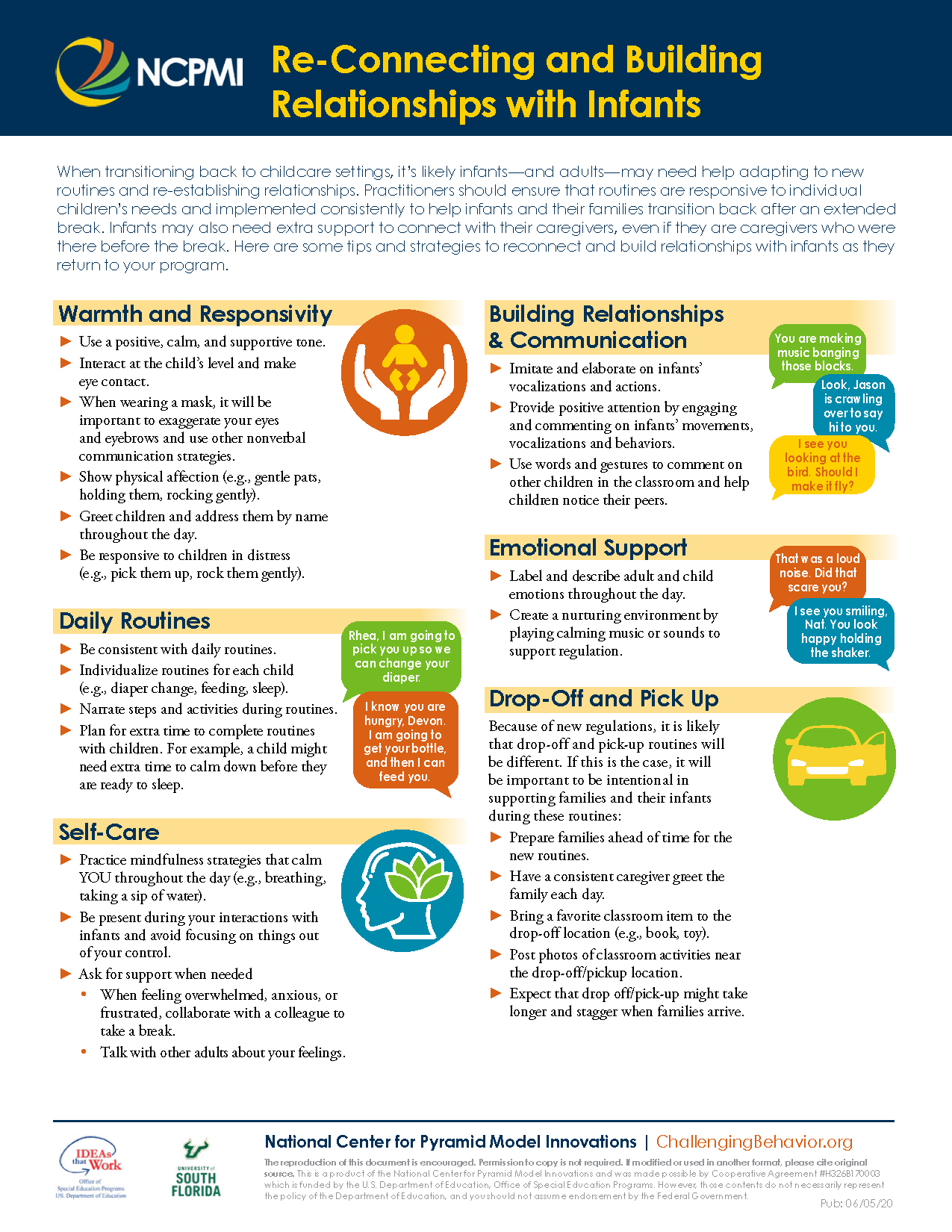
Use this tip sheet to help practitioners of infants and toddlers intentionally plan and think about how to reconnect, help children transition back to the classroom, and support children’s social and emotional development after being away from the program.
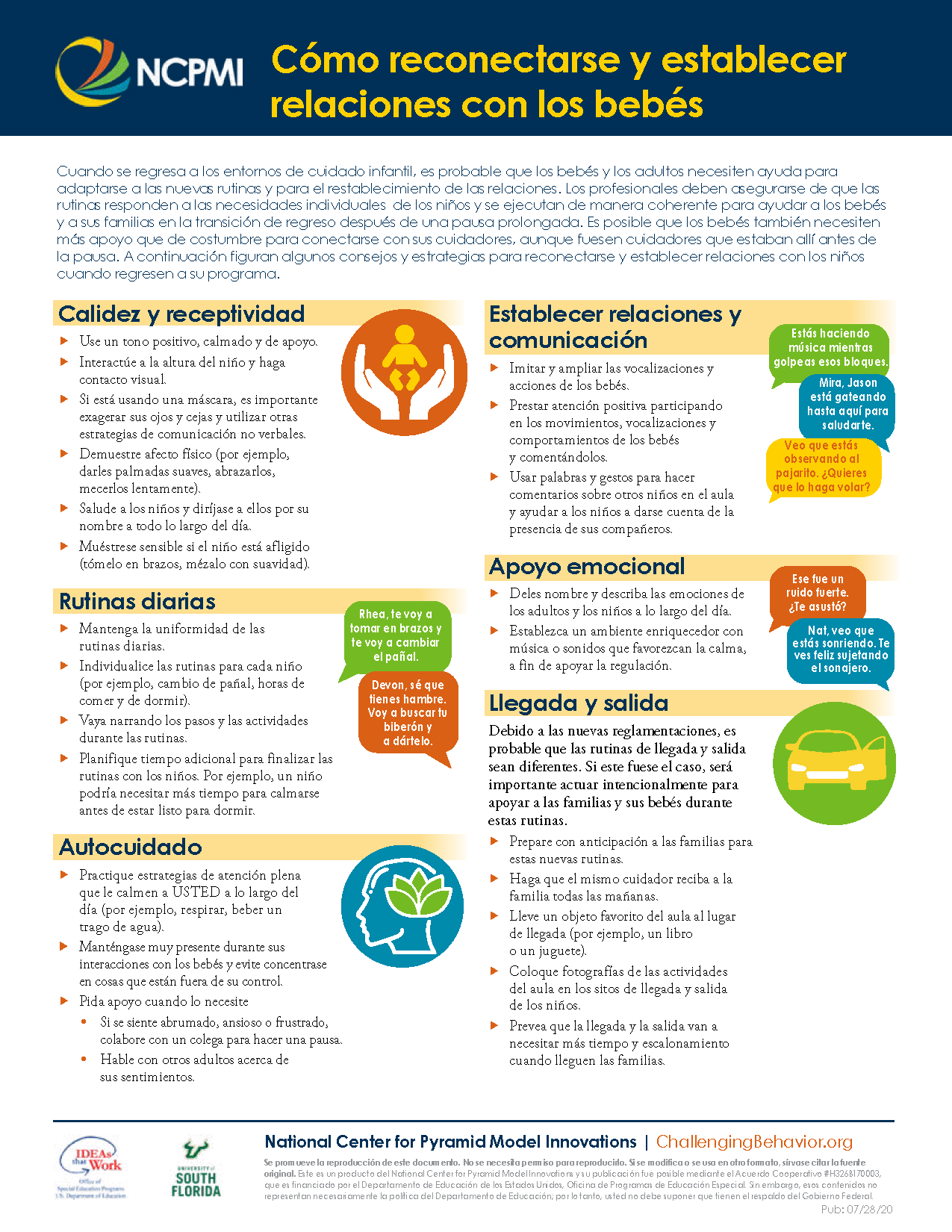
Use this tip sheet to help practitioners of infants and toddlers intentionally plan and think about how to reconnect, help children transition back to the classroom, and support children’s social and emotional development after being away from the program.
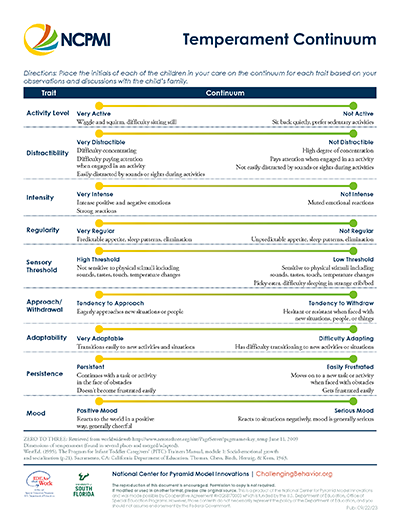
This form can be used by providers to help understand where children in their care fall on the temperament continuum.
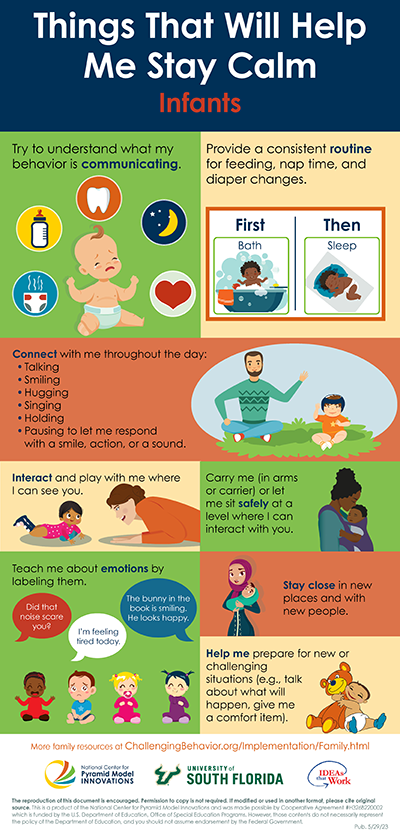
Caregivers can use the strategies in the infographic to provide infants with predictability in their day, and safety in relationships- all to support healthy attachment. Infants rely on the adults in their lives to read their cues, and help them to regulate as they adapt to their world. Responsive and positive interactions between infants and their caregivers help to build a strong attachment relationship. Positive attachment relationships support healthy brain development, and set babies up for success to learn about their emotions and build relationships as they grow into toddlers and preschoolers.

Caregivers can use the strategies in the infographic to provide infants with predictability in their day, and safety in relationships- all to support healthy attachment. Infants rely on the adults in their lives to read their cues, and help them to regulate as they adapt to their world. Responsive and positive interactions between infants and their caregivers help to build a strong attachment relationship. Positive attachment relationships support healthy brain development, and set babies up for success to learn about their emotions and build relationships as they grow into toddlers and preschoolers.
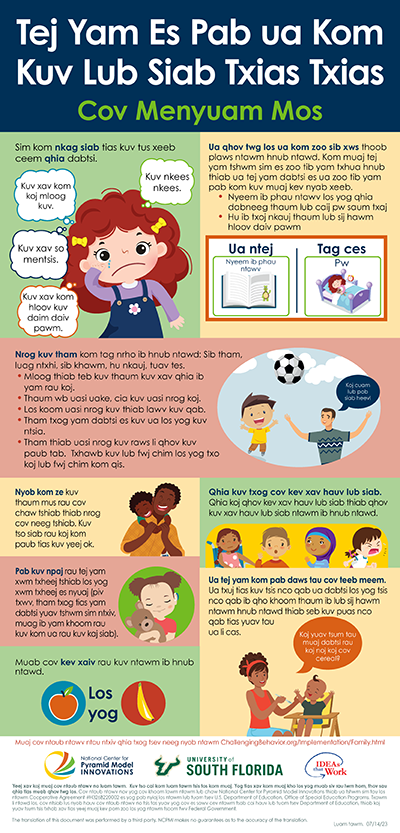
Toddlers experience big emotions as they learn to make meaning of their world and communicate their needs. Toddlers look to their primary caregivers to let them what they are experiencing is okay. Caregivers can use the strategies included in this infographic to provide toddlers with predictability in their day, safety in relationships, meaning to their experiences and emotions, and begin to build their problem-solving skills.
The translation of this document was performed by a third party. NCPMI makes no guarantees as to the accuracy of the translation.
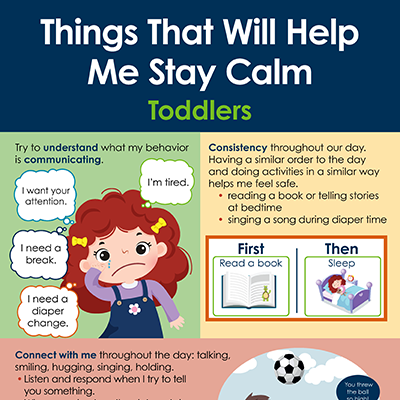
Toddlers experience big emotions as they learn to make meaning of their world and communicate their needs. Toddlers look to their primary caregivers to let them what they are experiencing is okay. Caregivers can use the strategies included in this infographic to provide toddlers with predictability in their day, safety in relationships, meaning to their experiences and emotions, and begin to build their problem-solving skills.

Toddlers experience big emotions as they learn to make meaning of their world and communicate their needs. Toddlers look to their primary caregivers to let them what they are experiencing is okay. Caregivers can use the strategies included in this infographic to provide toddlers with predictability in their day, safety in relationships, meaning to their experiences and emotions, and begin to build their problem-solving skills.

Toddlers experience big emotions as they learn to make meaning of their world and communicate their needs. Toddlers look to their primary caregivers to let them what they are experiencing is okay. Caregivers can use the strategies included in this infographic to provide toddlers with predictability in their day, safety in relationships, meaning to their experiences and emotions, and begin to build their problem-solving skills.
The translation of this document was performed by a third party. NCPMI makes no guarantees as to the accuracy of the translation.
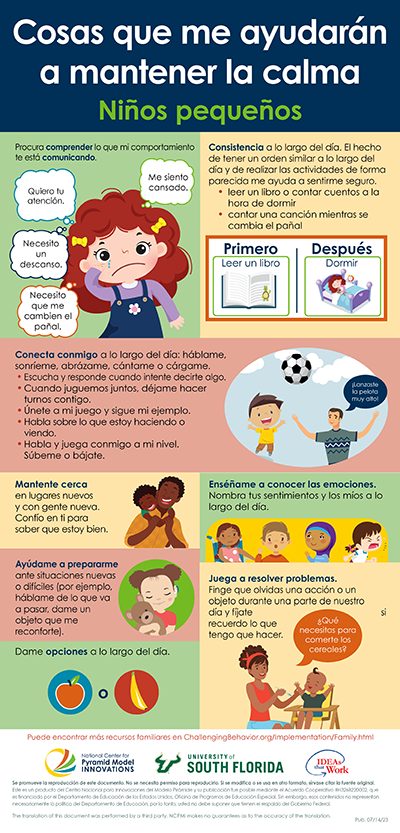
Toddlers experience big emotions as they learn to make meaning of their world and communicate their needs. Toddlers look to their primary caregivers to let them what they are experiencing is okay. Caregivers can use the strategies included in this infographic to provide toddlers with predictability in their day, safety in relationships, meaning to their experiences and emotions, and begin to build their problem-solving skills.
The translation of this document was performed by a third party. NCPMI makes no guarantees as to the accuracy of the translation.

The brief describes the importance of understanding temperament in infants and toddlers and provide references to more information about temperament.
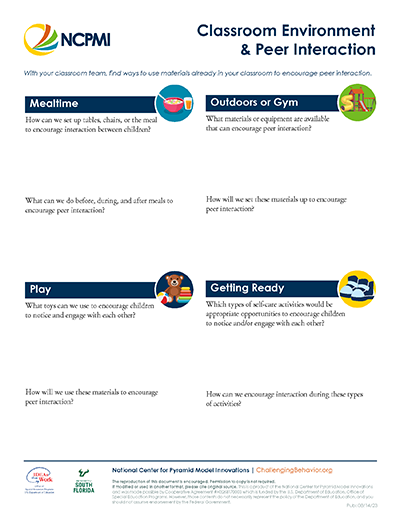
Providers and teachers can use this form to think through their current classroom environment and classroom materials and help them to plan out the ways they will use materials to encourage peer interaction.

This handout provides the developmental milestones of play skills for infant and toddlers.

This resource provides supportive strategies for the development of friendship skills of infant and toddler-age children.
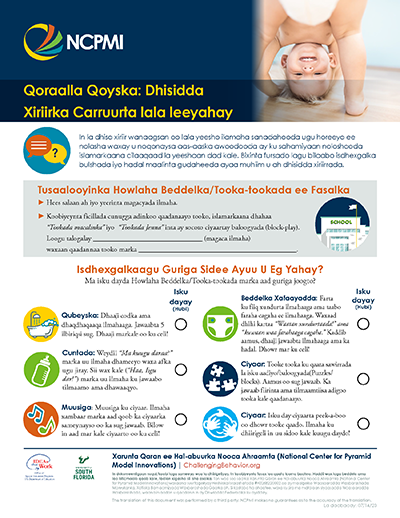
This resource provides teachers tools to promote families to build relationships with infants and toddlers. It includes a teacher’s guide for using the tool, a family handout, and an activity idea that teacher can use to communicate with families about building relationships with children.
The translation of this document was performed by a third party. NCPMI makes no guarantees as to the accuracy of the translation.
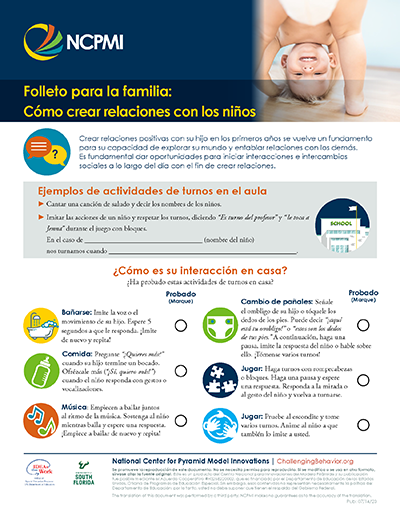
This resource provides teachers tools to promote families to build relationships with infants and toddlers. It includes a teacher’s guide for using the tool, a family handout, and an activity idea that teacher can use to communicate with families about building relationships with children.
The translation of this document was performed by a third party. NCPMI makes no guarantees as to the accuracy of the translation.

This resource provides teachers tools to engage families in teaching infants and toddlers about emotions. It includes a teacher’s guide for using the tool, a family handout, and an activity idea that teacher can use to communicate with families about teaching emotions.

This resource provides teachers tools to engage families in teaching infants and toddlers about emotions. It includes a teacher’s guide for using the tool, a family handout, and an activity idea that teacher can use to communicate with families about teaching emotions.
The translation of this document was performed by a third party. NCPMI makes no guarantees as to the accuracy of the translation.
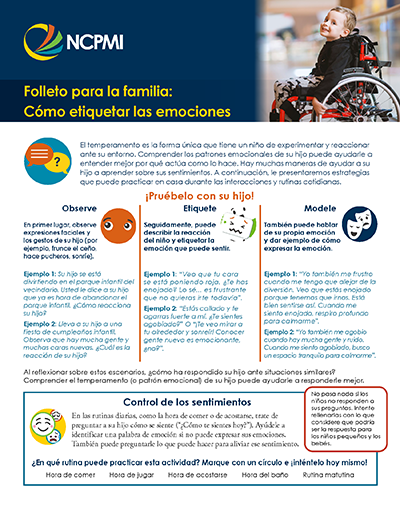
This resource provides teachers tools to engage families in teaching infants and toddlers about emotions. It includes a teacher’s guide for using the tool, a family handout, and an activity idea that teacher can use to communicate with families about teaching emotions.
The translation of this document was performed by a third party. NCPMI makes no guarantees as to the accuracy of the translation.

This resource provides teachers tools to promote families to build relationships with infants and toddlers. It includes a teacher’s guide for using the tool, a family handout, and an activity idea that teacher can use to communicate with families about building relationships with children.
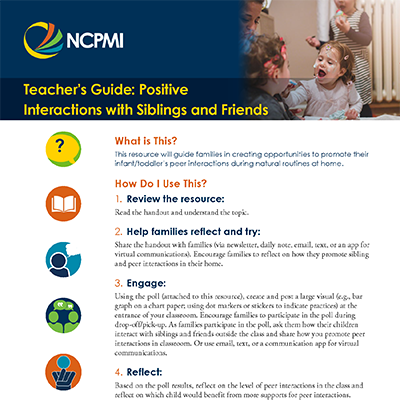
This resource provides teachers tools to engage families in promoting positive interactions between toddlers and their friends (or siblings). It includes a teacher’s guide for using the tool, a family handout, and an activity idea that teacher can use to communicate with families about their children’s play activities at home.

This resource provides teachers tools to engage families in promoting positive interactions between toddlers and their friends (or siblings). It includes a teacher’s guide for using the tool, a family handout, and an activity idea that teacher can use to communicate with families about their children’s play activities at home.
The translation of this document was performed by a third party. NCPMI makes no guarantees as to the accuracy of the translation.

This resource provides teachers tools to engage families in promoting positive interactions between toddlers and their friends (or siblings). It includes a teacher’s guide for using the tool, a family handout, and an activity idea that teacher can use to communicate with families about their children’s play activities at home.
The translation of this document was performed by a third party. NCPMI makes no guarantees as to the accuracy of the translation.

This resource provides teachers tools to build relationships with families. It includes a teacher’s guide for using the tool and two fill-in handouts for the teacher and families.
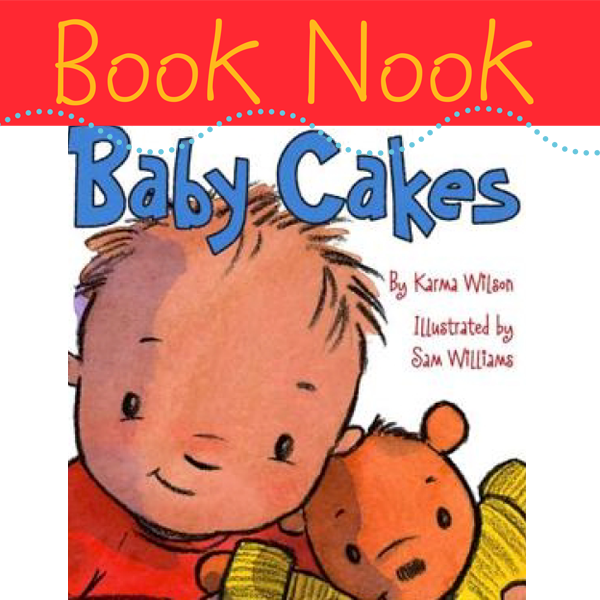
These easy-to-use guides were created especially for teachers/caregivers and parents to provide hands-on ways to embed social emotional skill building activities into everyday routines. Each book nook is comprised of ideas and activities designed around popular children?s books
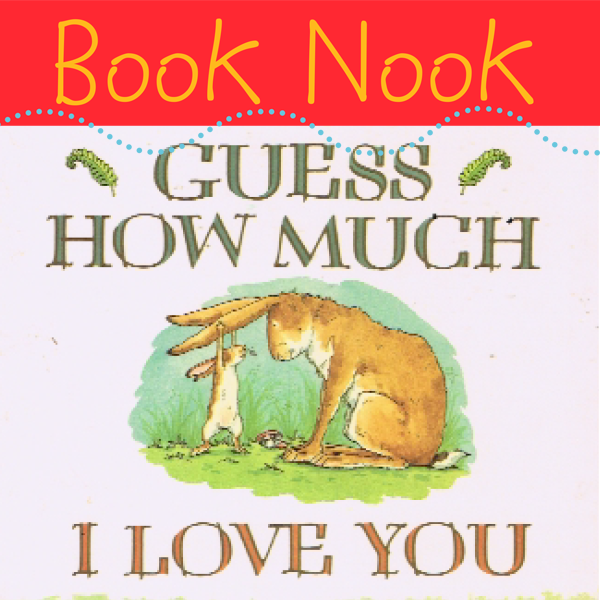
These easy-to-use guides were created especially for teachers/caregivers and parents to provide hands-on ways to embed social emotional skill building activities into everyday routines. Each book nook is comprised of ideas and activities designed around popular children?s books
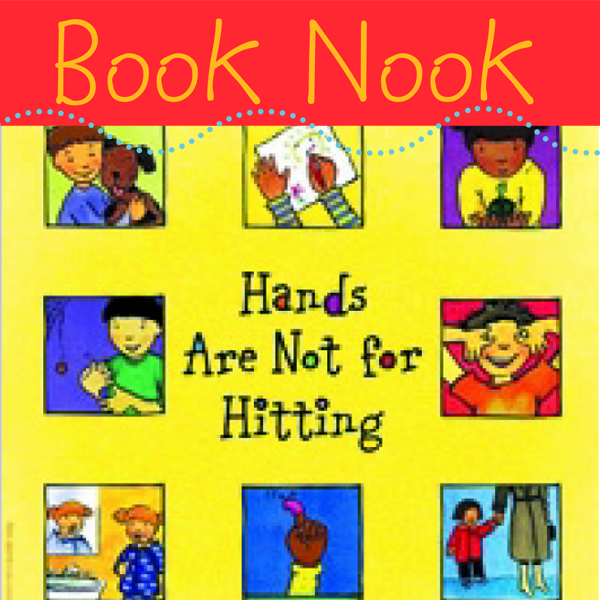
These easy-to-use guides were created especially for teachers/caregivers and parents to provide hands-on ways to embed social emotional skill building activities into everyday routines. Each book nook is comprised of ideas and activities designed around popular children?s books
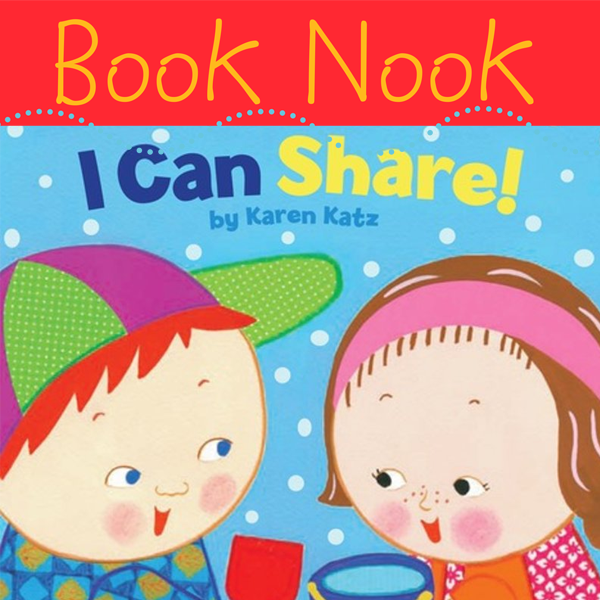
These easy-to-use guides were created especially for teachers/caregivers and parents to provide hands-on ways to embed social emotional skill building activities into everyday routines. Each book nook is comprised of ideas and activities designed around popular children?s books

These easy-to-use guides were created especially for teachers/caregivers and parents to provide hands-on ways to embed social emotional skill building activities into everyday routines. Each book nook is comprised of ideas and activities designed around popular children?s books
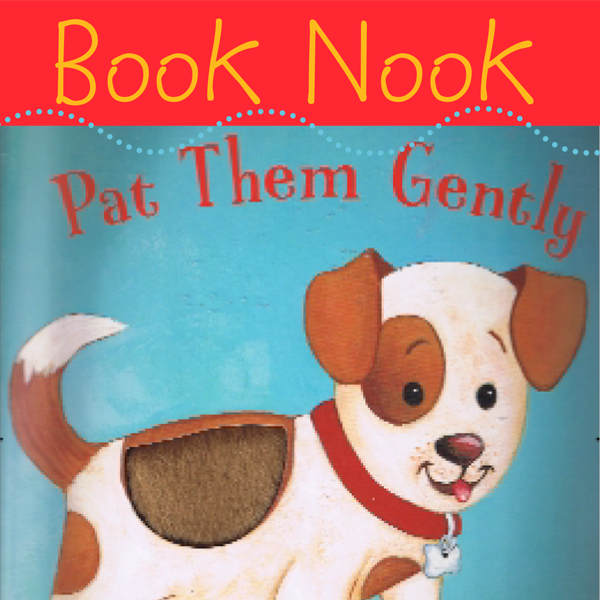
These easy-to-use guides were created especially for teachers/caregivers and parents to provide hands-on ways to embed social emotional skill building activities into everyday routines. Each book nook is comprised of ideas and activities designed around popular children?s books

These easy-to-use guides were created especially for teachers/caregivers and parents to provide hands-on ways to embed social emotional skill building activities into everyday routines. Each book nook is comprised of ideas and activities designed around popular children?s books

These easy-to-use guides were created especially for teachers/caregivers and parents to provide hands-on ways to embed social emotional skill building activities into everyday routines. Each book nook is comprised of ideas and activities designed around popular children?s books

This handout illustrates the components to better understand and respond to behavior in a format that is easy to print.
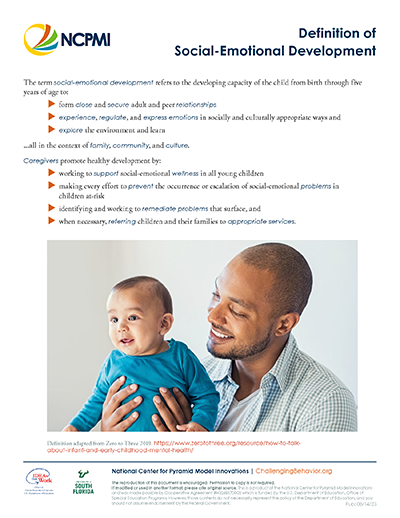
This fact sheet reviews the definition of social-emotional development.

Tip Sheet on various communication strategies for early childhood programs and teachers to communicate with families.
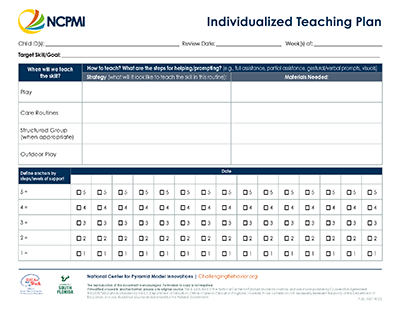
This individualized teaching plan provides teachers with a form for planning what they teach, how they will teach, and when they will teach new skills to children who need additional support.
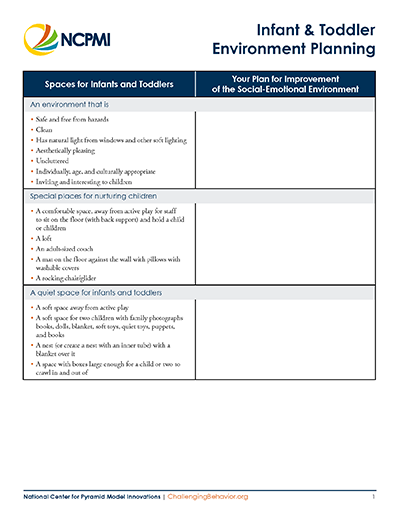
Providers and teachers can use this form to think through their current spaces for infant and toddlers as well as help them plan ways they will plan for improvement of the social-emotional environment.
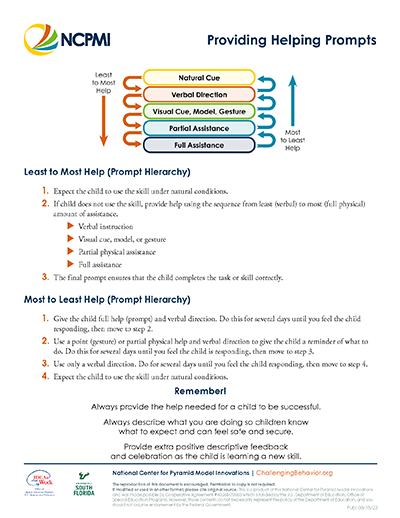
This resource providers teachers with visual reminders and helpful tips for providing helping prompts in the classroom when supporting infant and toddler children learn new skills.
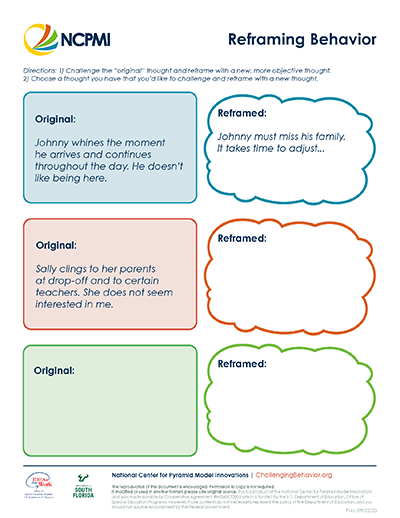
Use this form to reframe a behavior that challenges us into a more objective thought.
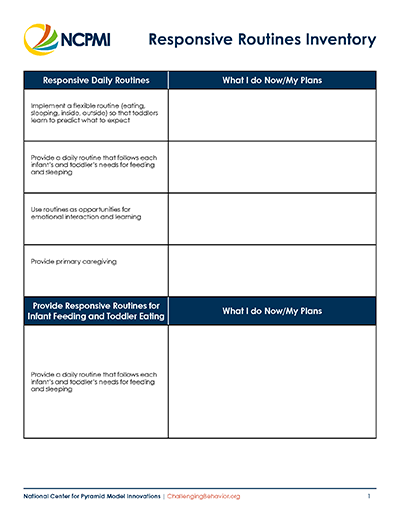
Providers and teachers can use this form to think through their current daily routines as well as help them to plan out the ways they will embed supports that are responsive to infant and toddler social-emotional development and teach new skills during specific moments in the day.

This Roadmap discusses family-focused services and practices for promoting social-emotional development of children served in Part C.
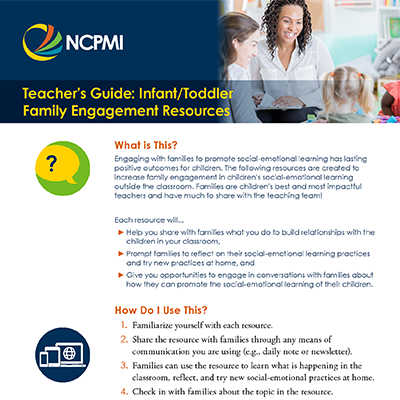
This guide introduces four resources that promote family engagement in infants’ and toddlers’ social-emotional learning outside the classroom. Included are a teacher’s guide for using the resources and links to the four family engagement resources.
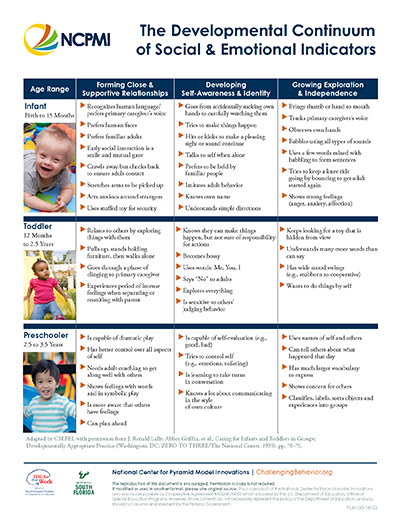
This one page fact sheet contains the developmental continuum of social and emotional indicators for infant, toddler, and preschool age children.



